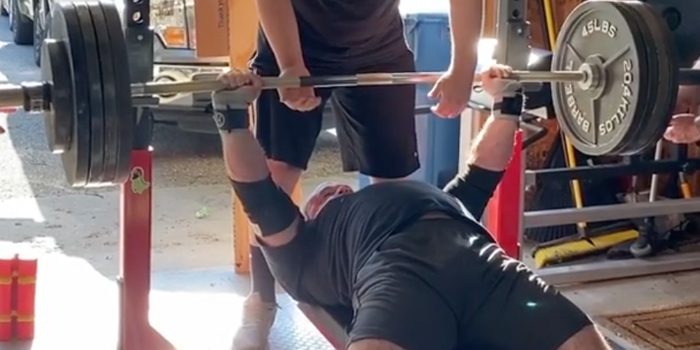
Author's Note: I'm not a physical therapist, orthopedist, or any other kind of physical healthcare provider. I'm simply an experienced meathead that has continuously dealt with pec injuries and has had to find ways to adapt my training to make it work. This is some of what has worked for me. Hopefully, it can be a source of ideas for you!
Strength train or powerlift long enough, and you are bound to get hurt (at least a little bit). Years of repetitive motion and pushing the body to its limits is going to end up with some amount of pain. That doesn't mean that everyone is going to end up with joint replacements and tendon detachments, but I do think it means we will all deal with some aches, pains, and "tweaks" along the way. My intention with this article is to help you avoid some of the "banged up" states.
For a long time, I avoided any time of upper-body injury. My raw bench press had continued to progress and was at the peak of rapid upward movement. I remember the night the first time I got hurt. A week or two prior, I had hit a huge PR, smashing what had been the previous meet's second attempt for an easy triple. I had my sights set on a massive bench press, and frankly, given my build and the progress I was making, it wasn't an unreasonable goal. Then it happened: A pop, crunch, and immediate pain during a relatively light set. It wasn't a total detachment, but something wasn't right. There was some kind of significant soft tissue injury that needed to be fixed.
RECENT: Resist the Urge to Compete
That was the start. It happened once every few months after that for a while, mostly because I was stubborn and didn't make any changes to avoid future injury for too long. Once the fact that I had a real problem got through my thick skull, though, I had to start making some changes. Here are a few of the tips that have helped the most.
1. Find an excellent "body mechanic"
By body mechanic, I mean physical therapist, chiropractor, massage therapist, and other tissue therapists. I have two that I love.
Vince Scheffler of Unlimited in Grand Rapids, Michigan, isn't just a joint cracker. He always does a significant amount of soft tissue manipulation on me, using different active and passive release techniques, trigger point therapies, Graston, and other methods. He does the traditional spine manipulations, followed by adjusting any other joints that need it (elbow, clavicle, wrist, etc.), then finishes up with targeted soft tissue work. I see Vince once a month, both preventively and whenever my body is messed up. I keep the appointment no matter what. I love that he does so much more than just adjusting my spine and believe that the biggest value I get is all the additional work that he does. That's the kind of chiropractor I think strength athletes should look for.
I see my massage therapist, Tamara Mitchell of Kalamazoo Athletic Wellness, in Kalamazoo, Michigan, once a month as well. These visits are usually offset from my visit to Vince by two weeks. Tamara is a high-level Olympic weightlifter, has a moderately aggressive massage technique, and just sort of "gets it" being a strength athlete herself—exactly why I picked her. I wanted a massage therapist that understood on some level what I was doing to myself. Seeing her once a month has helped me maintain range of motion, and I think prevents injury by working out the tight knots before they become a real problem.
Seek out these kinds of practitioners and see them regularly. The once a month cadence has worked great for me, you'll have to find the right frequency for you (and your budget). They will fix you up when you do get hurt and will go a long way to keep you from being injured in the first place.
2. Don't squat so often
Straight barbell squatting is the most aggravating thing for me when it comes to irritating my upper body. Getting under a straight bar puts an immense amount of stress on my wrists, elbows, and shoulders, usually leaving me sore in those areas afterward. One of the biggest changes I have made over the years is getting away from the straight bar and not squatting with it more than a couple weeks in a row. Consider these straight bar alternatives:
SS Yoke Bar: This bar will take the most pressure off the upper body and give it a break. I love utilizing it during deloads as well as incorporating it as a "heavy effort" variation. The caveat to this bar is that it does change the movement to some extent. It isn't quite the same groove and can't be a complete replacement for a straight bar. I think there is a detriment to using it too much in that you lose the flexibility to get under a straight bar. So, use the SS Yoke bar to give your upper body a break, but don't use it too often.
BUFFALO BAR™/Bow Bar: I love this bar. In my opinion, it is the best of both worlds and a great compromise between straight squat bars and specialty bars. The bow will give your upper body a break, but since the positioning will be very similar to a straight bar, the movement will stay relatively unchanged. For that reason, my opinion is that you can use this bar very often without having a significant negative effect on your squat. Perhaps an unpopular opinion: I don't like the bow bars that have a big camber to them (meaning a big curve). They start to change the movement and introduce a "swinging" component similar to a true cambered bar. My best experiences with bow bars have been ones that have only a slight curve to them. They give me the upper body rest I'm looking for while still feeling the same as a straight bar.
Cambered Bar: I don't own one and don't like using them. Certainly this bar can accomplish the same things as the other ones, I just don't have one and don't see enough value in it to spend the money on one since I already have the SS Yoke Bar. If you only have the budget or space for one, get the SS Yoke Bar. Programming Tip: Plan your heaviest benching for weeks when you aren't straight bar squatting. This is likely when your shoulders and elbows will be the freshest allowing for a less painful bench session and lower risk of injury. Rotate these specialty bars through your training and occasionally get away from the straight bar. Your upper body will thank you.
3. Don't bench press (full range) so much
The full range of motion barbell bench press puts the most stress on both the joints and the soft tissue (same logic and caveats as the squat). Again, same caveat, I think you have to do full range work regularly to maintain range of motion. You just shouldn't do it every single week. Here are a few variations to work with:
Board Pressing: I think this should be pretty obvious. Limit the range of motion so that the joints and soft tissues aren't stressed to their end ranges. Even something as simple as a one-board press, or even a half board, helps keep the stress off my body and is less painful. Anecdotally, I've never had a pec injury when board pressing. I think the lower boards make a great substitute while protecting the body. A half or one board is so close to the full range that the strength at those heights aren't likely to be much different.
Reverse Band Pressing: Another favorite of mine. Using the reverse band and making the load lighter at the bottom goes a long way to reducing stress during the bench press, all while getting the full range of motion and a heavy lockout effort. Warning: Keep your ego in check. A 315-pound bencher should not be using a strong band for this. The strength of the band should scale with the strength of the lifter.
Floor Pressing: Same logic as the board press. The only thing I don't like here is that getting the upper back set and form locked in seems more difficult. It is harder to get locked in position while floor pressing, so take time to make sure your body is set up tight and right.
4. Implement this stuff early
Perhaps the title is misleading. These ideas are all things that have helped me as my lifting age has advanced and nagging injuries have come creeping in. None of it has to wait until you are starting to feel the aches of experience! Don't wait until the first pec strain happens. I think if you wait that long you are fighting a losing battle and are only slowing the injuries down. I wish that I had known this stuff at the beginning of my lifting career. Start early, before your body hurts and take care of it before you need to. Proactive prevention will go much further than reactively trying to fix yourself.
I can't promise that any of this will help keep you from getting hurt or be much value in resolving an injury or pain. My own experience has been that after making these changes, my bench press has hurt less, I've been able to continue to make forward progress, and I haven't had any strain or other injury in nearly two years. Experiment, talk with professional healthcare providers, and figure out how to make some changes to best help your training and physical wellbeing.











Thanks for sharing!